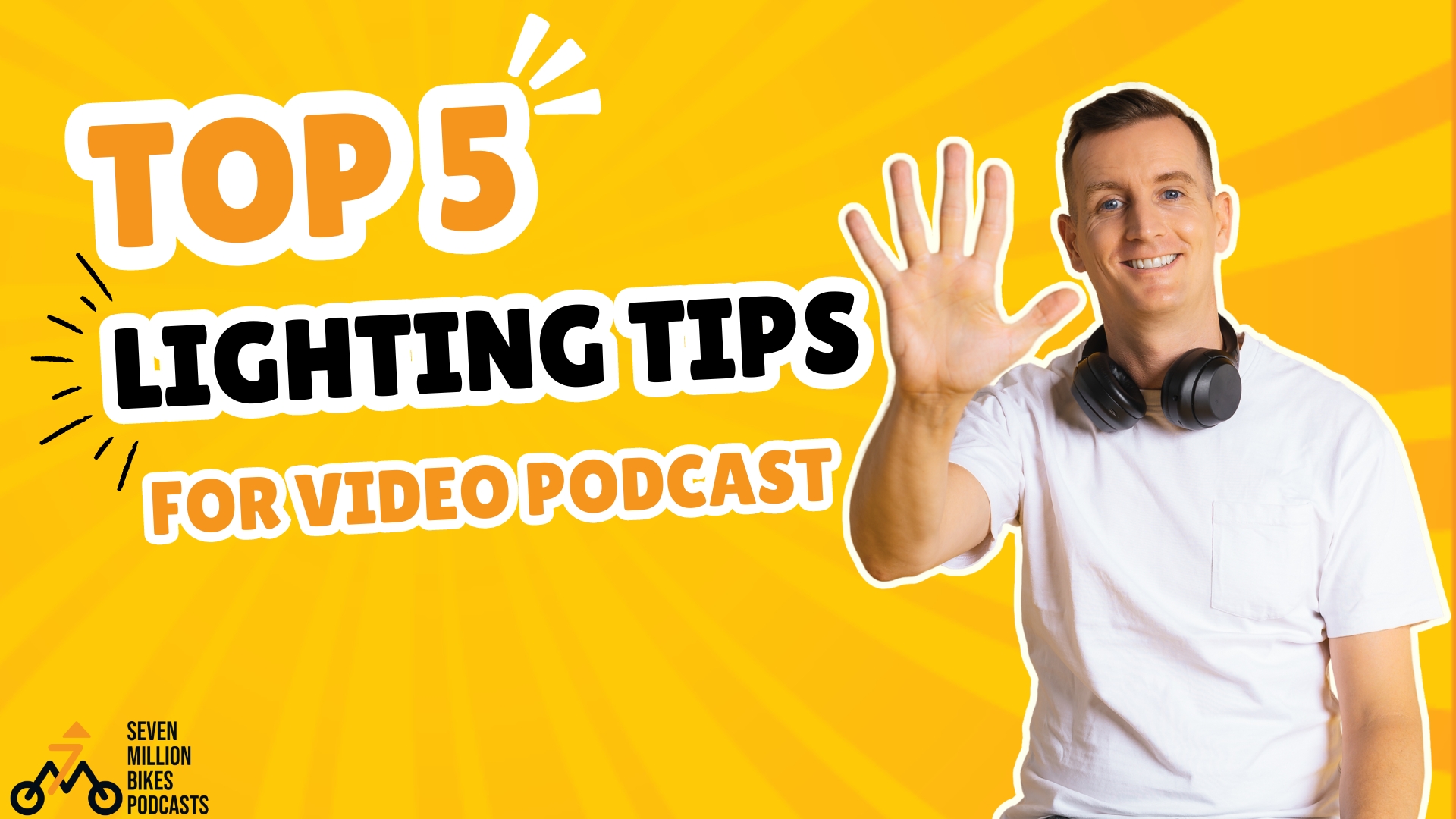In today’s rapidly growing podcasting landscape, video content has become just as important as audio quality. Let me help you go through 5 podcast lighting tips that help improve your video quality.
My name is Niall Mackay, founder of Seven Million Bikes Podcasts. I started my podcast as a hobby, and now it has turned into my full-time job. I help other podcasters improve their show by producing Smarter Podcasting podcast and offering podcast services.
I once thought that podcasts were all about audio, but now I’ve changed my mind as the video is important and engaging as well.
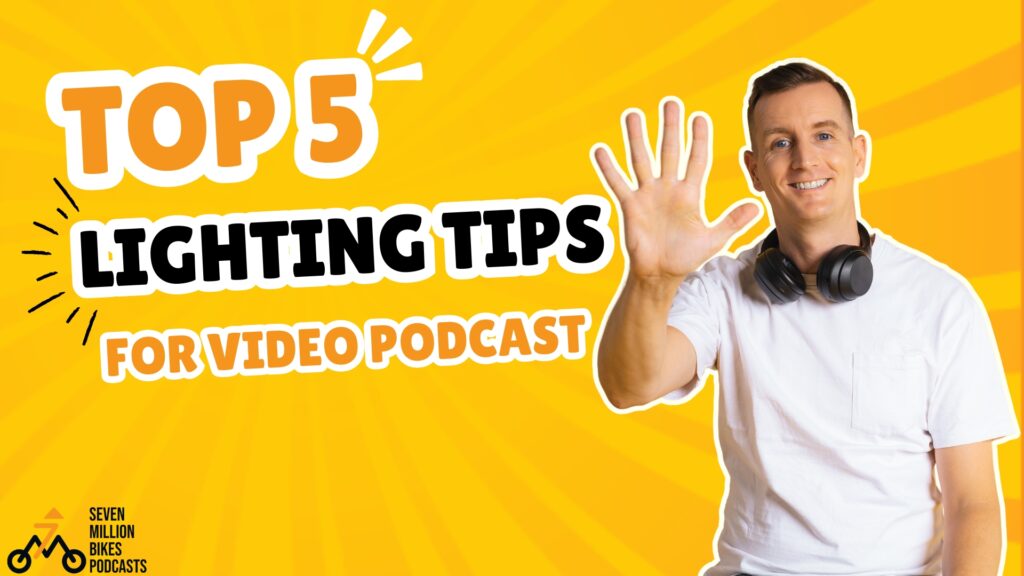
One of the most crucial aspects of high-quality video production is lighting. No matter how top-tier your podcast camera is or how captivating your content may be, bad lighting can result in a dull, unflattering image that leaves a negative impression on your audience.
This is a new skill that I haven’t mastered yet, but these are some of the tips i’ve learned along the way and am starting to put into practice.
In this blog, I’ll tell you the importance of lighting for video podcasts, the types of equipment you can use, and top tips for getting the best results.
Table of Contents
The Importance of Lighting – Why It Matters
Lighting is often an overlooked aspect of video production, yet it plays a crucial role in determining the overall quality and impact of your content.
First Impressions Matter
Lighting plays a huge role in how viewers perceive your video podcast. The moment someone clicks on your video, they’re forming opinions not just on what you’re saying but on how your podcast looks.
Poor lighting, however, can make your podcast look cheap and unprofessional, potentially deterring viewers from continuing to watch. Believe me, I know! Check out some of my first episodes on YouTube, the lighting was terrible!!
It’s still not perfect but has gotten a lot better.
Good lighting instantly adds a layer of professionalism, making your content look polished, credible, and worth watching. This simple yet crucial element helps you establish trust with your audience right from the start.
Lighting Affects Mood and Tone
Lighting doesn’t just impact how you look—it can also set the entire mood and tone of your video. Soft, warm lighting can create a cozy, relaxed vibe, making it perfect for casual, conversational podcasts. Cooler lighting, which is more neutral or even slightly blue, can lend a professional, serious atmosphere.
Different topics should have different lighting levels:
Casual, Conversational Podcasts:
- Soft, warm lighting: Create a cozy, relaxed atmosphere.
- Examples: Lifestyle podcasts, comedy shows, book clubs
Professional, Serious Podcasts:
- Cooler lighting: Lend a professional, serious atmosphere.
- Examples: Tech podcasts, educational shows, business news
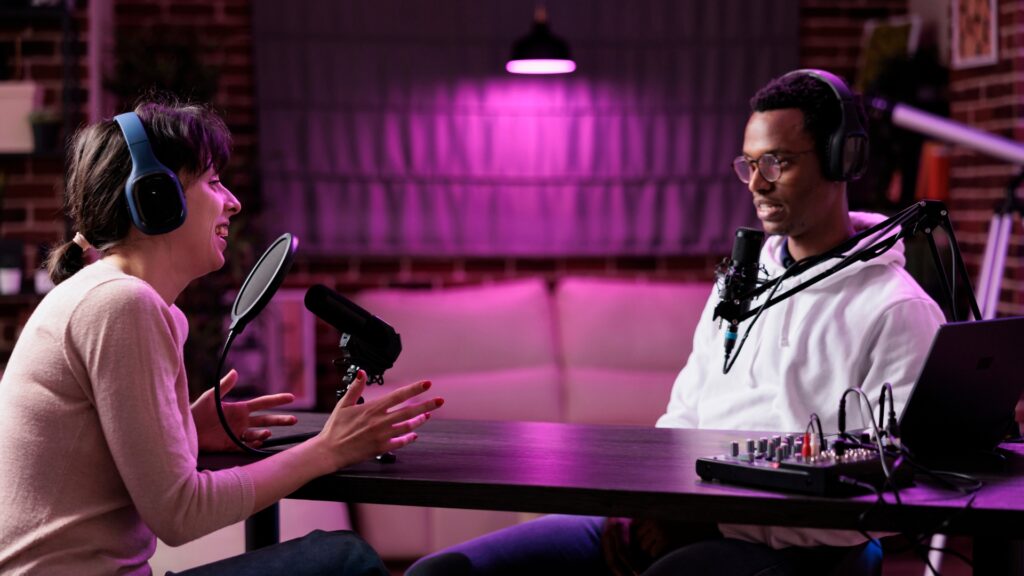
Motivational, Inspirational Podcasts:
- Bright, uplifting lighting: Create a positive and energetic atmosphere.
- Examples: Personal development podcasts, motivational speeches, success stories
By adjusting your lighting setup, you can communicate the right mood, whether you’re aiming for intimate, energetic, or informative.
Enhances Visual Quality
Proper lighting improves the visual quality of your podcast by improving clarity and detail. When you’re well-lit, facial expressions, eye contact, and body language are easily visible to your audience. This adds depth to your communication, making the content more engaging. Proper lighting also eliminates unwanted shadows and makes sure your face isn’t lost in dim or uneven lighting. It ensures your audience can focus on your message without distractions from lighting issues.
Influences Viewer Engagement
Well-lit videos do more than look good—they keep viewers engaged for longer. Studies have shown that high-quality visuals, including well-executed lighting, lead to increased viewer retention. When a podcast is visually pleasing, viewers are more likely to stay until the end and even come back for more. Bright, well-balanced lighting makes watching your podcast easier on the eyes, reducing strain and allowing your audience to focus on what’s being said. This is key to building a loyal audience that sticks with you episode after episode.
Podcast Lighting Tips: 5 Strategies for Your Video Podcast
Now it is the part that you’re waiting for. Let’s figure out 5 tips on how to enhance your lighting quality in video podcast.
Tip 1: Prioritize Natural Lighting Where Possible
When it comes to lighting your video podcast, nothing beats natural light. Natural light creates an appealing look for beginners and seasoned podcasters alike, instantly enhancing the overall video quality without the need for expensive equipment.
Here are the reasons why:
- Soft and Flattering: Natural light, especially during the “golden hours” (early morning and late afternoon), is soft and diffused, which creates a flattering, even illumination on the face.
- Cost-Effective: Natural light is free, making it an ideal solution for podcasters who are just starting out or those on a budget. You can achieve great video quality without investing in expensive lighting setups.
- Consistent with the Human Eye: Natural light feels more consistent with what the human eye is used to seeing. Viewers tend to feel more comfortable and at ease watching videos lit by natural light, as it mimics how we typically see the world.
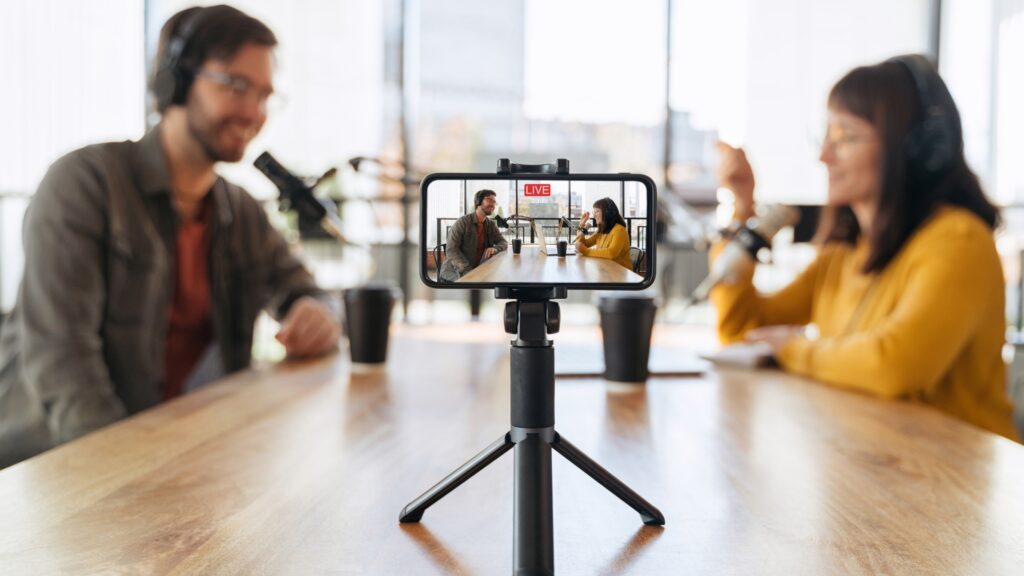
To make the most of natural light, always position yourself in front of or near a window, allowing the light to illuminate your face evenly. Avoid having the light source behind you, as this can cast shadows on your face or create a silhouette effect, making it difficult to see.
If the sunlight coming through your window is too harsh, you can easily soften it by using sheer curtains or blinds to diffuse the light. This will reduce any sharp shadows or overexposure, creating a more even and professional appearance.
Keep in mind that natural light changes throughout the day, so it’s important to plan your recording sessions when the lighting is optimal—such as early morning or late afternoon, commonly referred to as the “golden hours.” This is when the light is at its softest and most flattering.
Tip 2: Use a Three-Point Lighting Setup
For those looking to step up their video podcast lighting, adopting a three-point lighting setup is one of the most professional and balanced approaches. This classic lighting method involves three key lights: the key light, the fill light, and the backlight.
- Key light
The key light is your main source of illumination and should be the brightest. It’s typically placed at a 45-degree angle from your face, providing the primary light for your video.
- Filling light
Positioned on the opposite side of the key light, the fill light softens the shadows without overpowering the key light, ensuring your face is evenly lit.
- Backlight
Finally, the backlight is placed behind you to separate you from the background, adding a sense of depth to your shot. This prevents the video from looking flat and makes you stand out more clearly on camera. Together, these three lights work in harmony to provide a polished and professional look that enhances your video production.
A three-point lighting setup gives your video a more polished and professional appearance.
It ensures that your face is evenly lit, avoiding harsh shadows and dark spots. The three-point lighting setup can be adapted to various lighting conditions and subject matter, making it a versatile choice for video production.
Tip 3: Mind Your Lighting Angles and Placement
Even with great lighting equipment, poor placement can ruin your shot. The angle and placement of your lights are just as important as the lights themselves.
For example, placing lights directly above or below your face can cast unflattering shadows, such as under your eyes or chin, which can make you appear tired or unnatural.
The ideal setup is to position your lights at a 45-degree angle from your face. This helps avoid shadows while providing a balanced, even light. Also, be sure to keep the lights at or slightly above eye level. Lighting placed too high or too low can distort your features, but keeping it at eye level creates a more flattering, natural result.
Taking the time to experiment with angles and placement ensures that the light hits your face in the best way possible, highlighting your expressions and creating a clean, professional appearance.
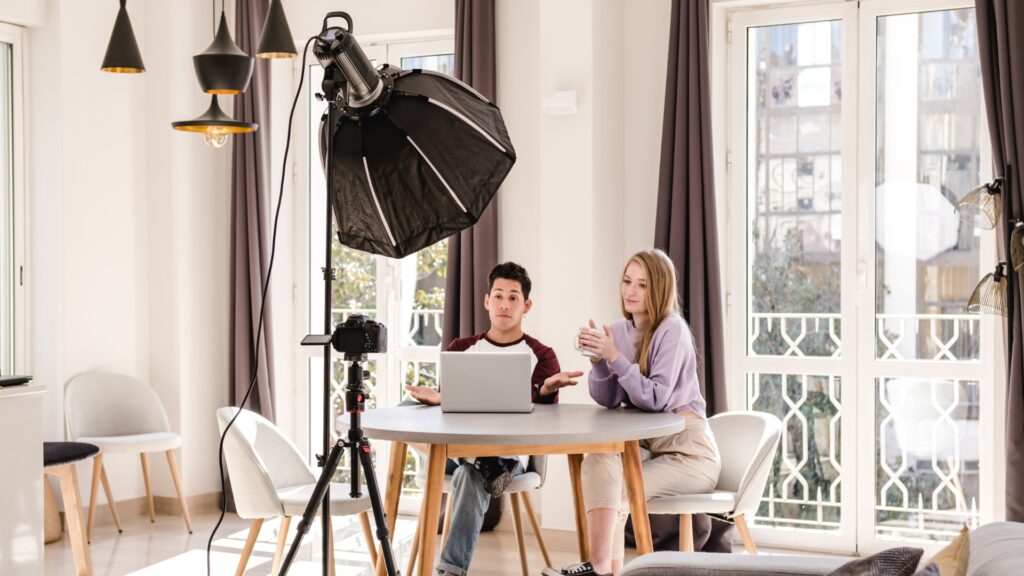
Tip 4: Control Brightness to Avoid Overexposure
Overexposure is a common problem when dealing with lighting in video production. It occurs when certain areas of your video are too bright, causing a washout effect that can obscure details and become distracting to your audience. To prevent this, controlling the brightness of your lights is crucial.
Invest in dimmable lights that allow you to adjust brightness levels to suit your environment. This flexibility is essential for creating the right balance between your artificial lights and any natural light in the room.
In addition to using dimmable lights, make sure to adjust your camera’s settings—especially the ISO and aperture. Lowering the ISO in bright environments reduces sensitivity to light, helping prevent overexposure.
If you find your video quality is over-bright, you can use some editing software and here are some ways to solve it:
- Color Grading and Exposure Adjustment
- Reduce Highlights
- Consider External Filters
Tip 5: Incorporate Ambient and Accent Lighting
While your primary lights are essential for illuminating your face, adding ambient and accent lighting can take your video production to the next level by enhancing the overall atmosphere and depth of your space.
- Ambient lighting refers to the general lighting that fills your room. It helps create a soft glow that evens out the lighting environment and reduces harsh contrasts. For example, overhead lights, floor lamps, or window light can serve as ambient lighting sources.
- Accent lighting adds personality and a touch of creativity to your background. This could include LED strips, small lamps, or even colored lights that match your podcast’s branding. These lights don’t need to be overly bright—they simply add warmth, depth, or color to your video, making it more visually engaging without distracting from your content.
To set the right mood, pay attention to the color temperature of your lights. Warmer lighting creates a cozy, intimate atmosphere, while cooler lighting feels more modern and professional. It’s important to ensure that all your lighting – whether ambient, accent, or key lighting – shares a consistent color temperature.
Some Equipment To Improve Your Lighting
When it comes to improving the lighting in your video podcast setup, investing in some essential equipment can make a big difference. There are some pieces of equipment that can be your assistant in lighting.
Softbox Lights
Softbox lights are essentially boxes with a light source inside and a diffusing material on the front.
The main advantage of softbox lights is that they reduce harsh shadows, giving your video a smooth and professional appearance. By softening the light, they create a more flattering and natural look, which is crucial for enhancing the visual quality of your content.
If you’re just starting out, there are budget-friendly options available, like softbox kits from Neewer, which offer excellent quality at a lower price point.
Ring light
Known for its simplicity and effectiveness, the circular design provides an even light source that minimizes shadows and highlights your face beautifully. One unique feature of ring lights is the signature “catchlight” effect they create in your eyes, which gives your videos a polished, professional feel.
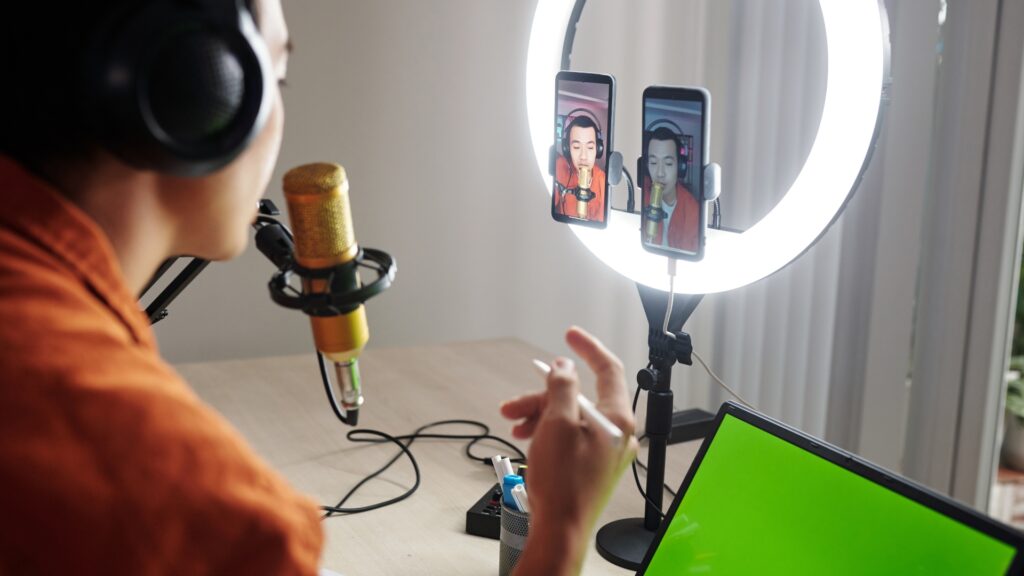
LED panels
These lights are adjustable in both brightness and color temperature, allowing you to customize your lighting setup according to the mood and tone of your podcast. They’re compact and lightweight, making them ideal for small spaces or mobile setups.
The ability to adjust the color temperature is particularly helpful, as you can create a warmer, cozier atmosphere or a cooler, more professional look depending on the vibe you want to convey.
Diffusers And Reflectors
Diffusers soften harsh light, ensuring that it is more evenly spread across your face, while reflectors bounce light into areas that need more illumination. For instance, a reflector can brighten up your face by redirecting light into shadowed areas without the need for additional lighting.
These tools help create a more balanced and even look, making them a simple yet effective way to enhance your video podcast setup.
Conclusion
In conclusion, lighting plays a crucial role in the quality and professionalism of your video podcast. Poor lighting can detract from even the best content, while thoughtful lighting can enhance your on-camera presence and create a more immersive viewing experience.
By maximizing natural light, investing in the right equipment, and applying techniques, you can significantly improve the production value of your podcast.
If you have any difficulties or questions about producing your show, don’t hesitate to Book A FREE Consultation!
Podcasters out there, if you have your podcast community with dedicated listeners, it’s time to turn them into loyal buyers! Let me help you with 5 secrets in my FREE E-book!
Don’t miss out on this opportunity to boost your podcast’s revenue.

